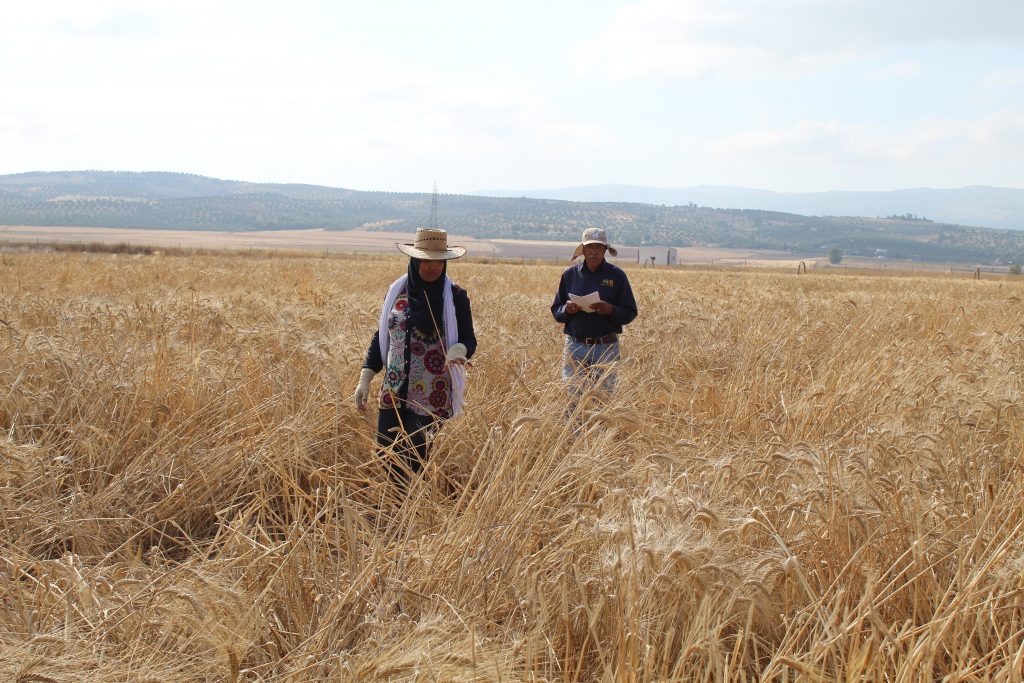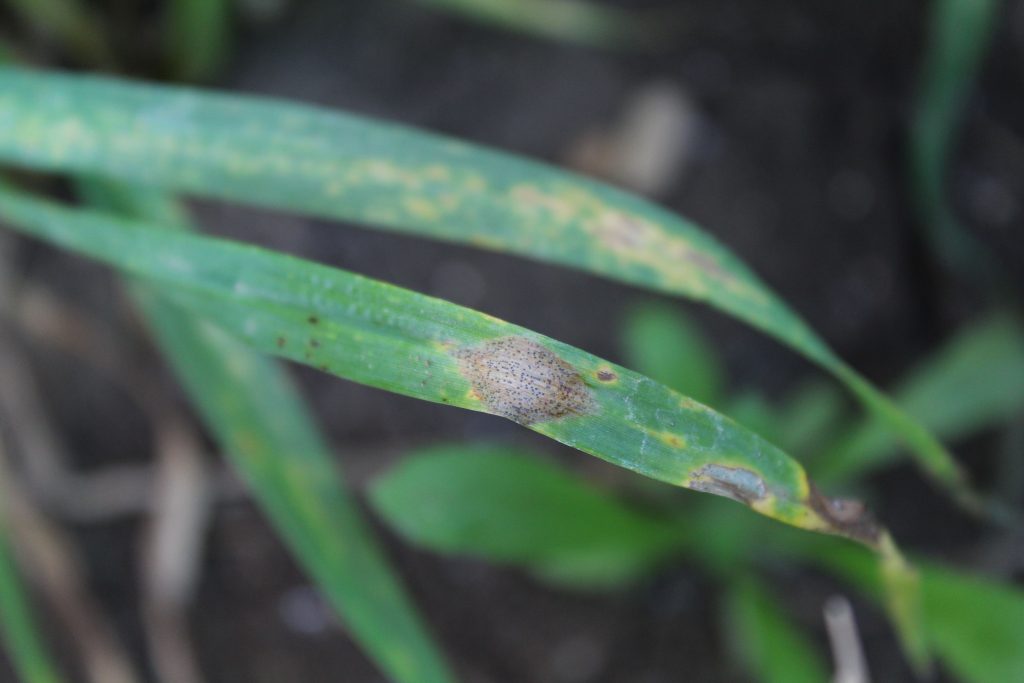Building resistance in wheat: International collaboration fights Septoria tritici blotch disease
Tunisia-based Septoria phenotyping platform plays critical role in identifying sources of resistance to the disease

Phenotypic selection of resistant lines (Ms. H. Kouki Field technician and CIMMYT consultant A. Yahyaoui) at the Septoria Precision Phenotyping Platform at Kodia/INGC (Photo: Septoria Precision Phenotyping Platform)
Tunisia has been a major durum wheat producer and consumer since Roman times, a crop used now for couscous, bread and pasta dishes throughout North Africa and the Mediterranean Basin.
However, a persistent disease known as Septoria tritici blotch (STB) has been threatening durum wheat harvests across the country thanks to its increasing resistance to fungicides and adaptability to harsher climatic conditions. The disease, which is caused by the fungus Zymoseptoria tritici, thrives under humid conditions and can cause up to 60% yield loss in farmers’ fields.
To help fight this disease, the International Maize and Wheat Improvement Center (CIMMYT) established the Septoria Precision Phenotyping Platform in collaboration with the Institution of Agricultural Research and Higher Education of Tunisia (IRESA) and the International Center for Agricultural Research in the Dry Areas (ICARDA) in Tunisia in 2015.
The platform aims to accelerate the transfer of STB resistance genes into elite durum wheat lines from national and international breeding programs, particularly CIMMYT and ICARDA breeding programs. Researchers at the platform have tested an impressive diversity of durum wheat lines for resistance to the disease from research institutes across Tunisia, Morocco, Algeria, Mexico, France, Italy, the UK, USA and Canada.
“New and more virulent strains of the pathogen are constantly emerging, which results in previously resistant wheat varieties becoming more susceptible,” said Sarrah Ben M’Barek, head of the laboratory at the Septoria Precision Phenotyping platform.

Field phenotyping – the use of field-testing to identify desired plant traits — is the heart of the platform. Scientists can test as many as 30,000 plots each year for STB resistance.
Evaluations are conducted at two main field research stations managed by the Regional Field Crop Center (CRRGC) and the National Institute of Field Crops (INGC), based at two major hotspots for the disease in Beja and Kodia. This work is complemented by laboratory research at the National Agronomic Institute of Tunisia (INAT) at Tunis.
“The platform plays a critical role in identifying STB resistant wheat germplasm and characterizing the resistance genes they possess. These resistant sources be can further utilized in hybridization schemes by durum wheat breeders worldwide to develop durable resistant varieties,” explained CIMMYT consultant and platform coordinator Amor Yahyaoui.
With the help of data from the platform, breeders hope to combine multiple resistance genes in an individual variety to create a genetically complex “lock” whose combination the fungus will not easily break.
According to Ben M’Barek , the huge genetic diversity in wheat and its ancestors has helped breeders to develop new varieties for almost a century. However, the adoption of new varieties has typically been slow.
Farmers in Tunisia traditionally rely on fungicides to manage the disease. However, with the pathogen recently becoming more resistant to fungicides and more adaptive to harsher climatic conditions, interest in STB resistant varieties is increasing.
A hub for training and collaboration
The platform is also a hub for training and capacity development for national and international scientists, field research and lab assistants, students and farmers. It brings together research staff and technicians from different institutions within Tunisia including the CRRGC, INGC, the National Institute of Agricultural Research of Tunisia (INRAT), INAT and the University of Jendouba.
Farmer’s organizations and regional extension services, as well as private organizations such as Comptoir Multiservices Agricoles (CMA), seed and chemical companies also collaborate with the platform. The result is a team effort that has generated a tremendous wealth of data, made only possible through the dedication of Yahyaoui, said Ben M’Barek.

“Spending a few days at the platform each year is a like a crash course on STB resistance. All subjects are covered and great experts around the world come together to discuss all details of this host-pathogen interaction,” said Filippo Bassi, senior durum wheat breeder at ICARDA.
“Sending young scientists to spend some time at the platform ensures that they learn all about the mechanisms of resistance and take them back to their home country to deploy them in their own breeding programs. It is like a true university for STB.”
Yet, the platform still has a lot of work to do, according to Ben M’Barek. Scientists at the platform are now working on raising awareness on crop and pest management such as integrated management approaches amongst farming communities, setting up on-farm field trials and developing disease early warning surveillance.
Next year the platform will provide a unique podium for students, academics and researchers to exchange ideas and research findings on cereal leaf blight diseases. The International Symposium on Cereal Leaf Blights will take place on May 19-21, 2021 in Tunisia. Details can be found here.
The Septoria Precision Phenotyping Platform is led by the International Maize and Wheat Improvement Center (CIMMYT), in collaboration with the Institution of Agricultural Research and Higher Education of Tunisia (IRESA) and the International Center for Agricultural Research in the Dry Areas (ICARDA) and is supported by the CGIAR Research Program in Wheat (WHEAT).




